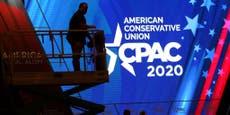Trump returns: How CPAC could fire the starting pistol for the 2024 White House race
The Republican establishment has for years used CPAC as a vital platform. But that establishment now looks very different
Your support helps us to tell the story
From reproductive rights to climate change to Big Tech, The Independent is on the ground when the story is developing. Whether it's investigating the financials of Elon Musk's pro-Trump PAC or producing our latest documentary, 'The A Word', which shines a light on the American women fighting for reproductive rights, we know how important it is to parse out the facts from the messaging.
At such a critical moment in US history, we need reporters on the ground. Your donation allows us to keep sending journalists to speak to both sides of the story.
The Independent is trusted by Americans across the entire political spectrum. And unlike many other quality news outlets, we choose not to lock Americans out of our reporting and analysis with paywalls. We believe quality journalism should be available to everyone, paid for by those who can afford it.
Your support makes all the difference.Donald Trump’s post-presidency return to public speaking is finally confirmed. Blessed with his presence will be the Conservative Political Action Conference, or CPAC, the annual convention that pulls together the US’s right-wing elite to strut their stuff or blow off steam, depending on their mood.
Now approaching its 50th birthday, CPAC is a project of the American Conservative Union, one of the US’s oldest right-wing lobby groups. Designed to bring together conservatives from all over the country to exchange ideas and forge useful relationships, its ostensible main function today is to galvanise the movement’s disparate groups around their shared issues.
But the conference also has other key functions: it helps sharpen the line between establishment and counter-establishment, tightens the connections between Republican officials and the party’s donor class and interest groups, and gives rising stars a chance to show off as they climb the ladder.
On that last point, this year’s schedule features some telltale names: South Dakota governor Kristi Noem, Arkansas Senator Tom Cotton, Texas Senator Ted Cruz and Missouri Senator Josh Hawley all have solo speaking slots. But with Mr Trump the headline slot on the final day, the four of them are for now being kept firmly in line.
The conference has always been a useful platform for airing out the right’s culture war grievances, albeit in an upbeat spirit. Regular speakers over the years have included not just elected officials but leaders from the NRA and other conservative pressure groups, Fox News pundits, and the likes of Ann Coulter, a right-wing provocateur known for adopting incendiary views on race and immigration.
Some of the speakers and groups attending have gone even further beyond the fringe, periodically threatening to derail the conference’s reputation. In 2017, CPAC was forced to disinvite Milo Yiannopoulos over remarks he made about intergenerational sex (though his previous antisemitic, racist and misogynistic statements had been no problem).
It’s also an ideal stage for Republicans looking to maintain or salvage their national profiles, or at least to stay in touch with the base between election cycles. Back in 2013, coming off Barack Obama’s victory over the relatively mainstream campaign fought by Mitt Romney, proto-Trump Tea Party heroine Sarah Palin – not yet relegated to has-been status – gave one of her reliably earthy, free-associative speeches.
“He’s got the rifle, I’ve got the rack,” she quipped as she discussed her and her husband’s Christmas gifts. Then she pulled from under the podium an extra-large Big Gulp cup full of an unidentified substance and took a sip. Venting their rage at Michael Bloomberg’s proposed cap on large-size soda servings, the crowd went wild.
“Sure, it’s just pop with low-cal ice cubes in it!” Ms Palin riffed. “I hope that’s okay.”
Contained in that brief moment is everything that CPAC has become: a forum for venting cultural and political grievance, a chance for leaders to shore up their credibility, and a multi-day rally that gets useful TV coverage for a cheering conservative crowd.
The priorities of the conservative movement shifted radically over the course of the second Obama term. A month into Mr Trump’s presidency, the CPAC of 2017 saw Steve Bannon, the far-right co-mastermind of Mr Trump’s victory, take the stage for a rare public appearance where he laid the administration’s agenda bare for all to see.
Talking of “economic nationalism” and the imperative to defend “sovereignty” at all costs, Mr Bannon explained that Mr Trump’s cabinet had been chosen to spearhead “the deconstruction of the administrative state” in favour of consolidated executive power.
But he also laid out the nationalistic creed to which Mr Trump openly pandered as he steadily took over the Republican Party: “We are a nation with a culture and a reason for being.”
It was at CPAC’s 2011 meeting, in fact, that Mr Trump gave his first major political speech. At the time, he was aggressively pushing the racist fiction that Mr Obama was not born in the US and therefore could not be considered a legitimate president; on the stage, he took digs at the candidates lined up for the next election and ranted about issues that would animate his campaign when it kicked off four years later, in particular trade with China.
Nine years on, he gave a rambling address to the conference just as the US was starting to feel the impact of the coronavirus pandemic. And not long after the conference closed, it became clear that at least one guest had tested positive for Covid-19.




Join our commenting forum
Join thought-provoking conversations, follow other Independent readers and see their replies
Comments